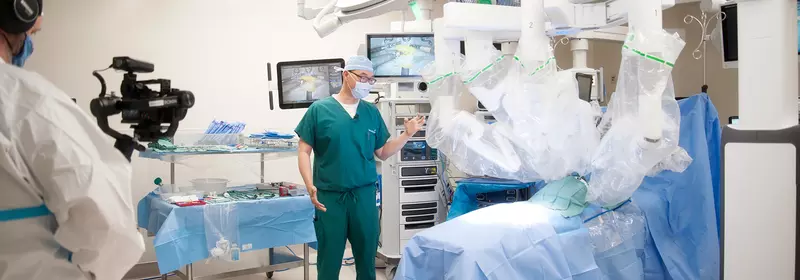Leading the Way in Robotic Surgery and Whole-Person Care
When Mark Rice first learned he had prostate cancer, his physician didn’t recommend surgery as an initial treatment option.
“It wasn’t a very aggressive type of cancer,” the 60-year-old Rome resident said. “The initial treatment plan was to keep checking my PSA (prostate-specific antigen).”
But following additional tests, Rice, who has a family history of prostate cancer, decided to move forward with having AdventHealth Gordon’s fellowship-trained urological oncology surgeon Hak Lee, MD, remove his prostate via robotic-assisted surgery in June 2022.
“I’m glad I did,” he said.
Small amounts of PSA proteins normally circulate in the blood, but elevated PSA levels can be an early indication of cancer of the prostate, a small gland below the bladder that helps produce seminal fluid in men.
Rice said his follow-up bloodwork showed higher PSA levels, while he received a low Gleason score after a biopsy of his prostate tissue. The Gleason score, which is calculated after examining normal and abnormal cell patterns in the tissue, serves as another factor physicians consider when developing a patient’s cancer treatment plan.
“Once the pathology report came back, it showed the cancer had become a lot more aggressive, so it’s a good thing I went ahead and did treatment instead of surveillance,” he said.
Rice said he opted for robotic surgery after discussing the benefits with Dr. Lee, whose research into the minimally-invasive procedure began in 2007 while he was completing a urology residency at the University of California, Irvine.

Robotic Surgery at AdventHealth
Following his completion of a urological oncology fellowship featuring robot-assisted surgeries at UC San Diego, Dr. Lee brought his expertise to AdventHealth Gordon in 2015 as its director of robotic surgery and urology.
“The hospital didn’t have a robot or a robotics program when they hired me, and I said, ‘We need to have a robotic program because that’s where surgery is headed,’” he recalled.
Today, he’s joined by four other board-certified surgeons who have mastered the cutting-edge da Vinci Xi robotic surgery equipment: obstetricians and gynecologists Joy Nwadike, MD, and Donald Taylor, MD; and general surgeons Briton Jordan, MD, and Carl Lokko, MD.
In March, the multi-disciplinary team reached a milestone by completing their 1,000th robotic surgery. Types of robotic surgeries included in this number are nephrectomies, partial and complete, adrenalectomies, prostatectomies, pyeloplasty, total hysterectomies, hernia repairs and more.
Since 2015, AdventHealth Gordon has been the only hospital in Northwest Georgia to deliver comprehensive, advanced patient care by way of multi-specialty robotic surgery.
“I was very grateful to have something so close to us so we didn’t have to drive to a bigger city,” Rice said.
Dr. Lee continues to oversee the program’s growth.
“We’re introducing the opportunities of the program and of our practice to the provider offices in our community,” he said. “We’re building awareness with our partners in Rome at AdventHealth Redmond. We’re developing more resources for our patients that include options for online support, including education and support groups.”
In addition, he has brought high school students with aspirations of becoming surgeons to the hospital for hands-on learning opportunities with robotic technology.
The da Vinci Xi system, which AdventHealth Gordon has been using since 2021 as an upgrade from its original system, allows for a series of small incision entry points, as well as more control over the instruments, resulting in less tissue damage and blood loss and quicker recovery periods.
The surgeon controls the instruments, which mimic human hand, wrist and finger movements, via a console located next to the patient during the surgery.
“The robot can rotate 360 degrees from any location,” Dr. Lee said.
It also pairs with TruSystem technology to wirelessly sync the operating table to the robot, allowing the surgeon to dynamically position the patient and work from all angles and positions they would otherwise have trouble accessing.
The innovative technology also magnifies the surgical field up to 10 times beyond what the human eye can see for a more detailed 3D view of the operating site.
“The benefits are far greater than what we used to offer,” Dr. Lee said.

Life After Surgery
Rice, a retired government loan underwriter who now works part-time as a courier for a local technical college, said he didn’t need to take pain medications after the three-hour surgery.
“Right after the surgery, there was no pain, no discomfort,” he said. “I came home the next day and didn’t need any pain meds once I got home either. I was back at work in six weeks and probably could have done it a little sooner.”
He praised Dr. Lee, his nurse navigator and the rest of his care team at AdventHealth Gordon for the compassionate care he and his wife and daughter received from start to finish.
“Everybody was helpful from day one,” he said. “They were there every step of the way. I couldn’t be more pleased with the results or with the people we were working with. I couldn’t have asked for a better experience.”
Today, Rice is enjoying outdoor adventures, walks in the park and lifting weights at the gym again.
“At my six-month follow-up, there was no detectable cancer,” he said. “I have peace of mind knowing we had the surgery, and the cancer has been removed. My prognosis is very good.”

Start Your Care
Our Robotic Clinical Coordinator will walk with you, every step of the way. We understand that facing surgery is a difficult time. At AdventHealth Gordon, we are committed to providing every patient a compassionate environment with a thorough, professional, and complete evaluation. From scheduling appointments to daily follow-ups after surgery, our clinical coordinator strives to ensure our patients are well-supported and informed throughout their entire surgical process.
To get started, get in touch with our Robotic Clinical Coordinator today by calling Call706-602-7800 x4052. For more information about our specialties, please call:
Urology:
Call706-879-4700
General Surgery:
Call706-602-8300
Gynecology:
Call706-879-5770

